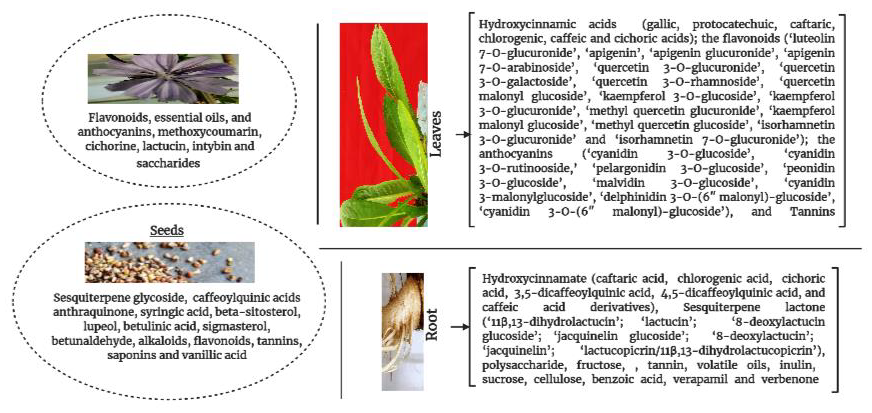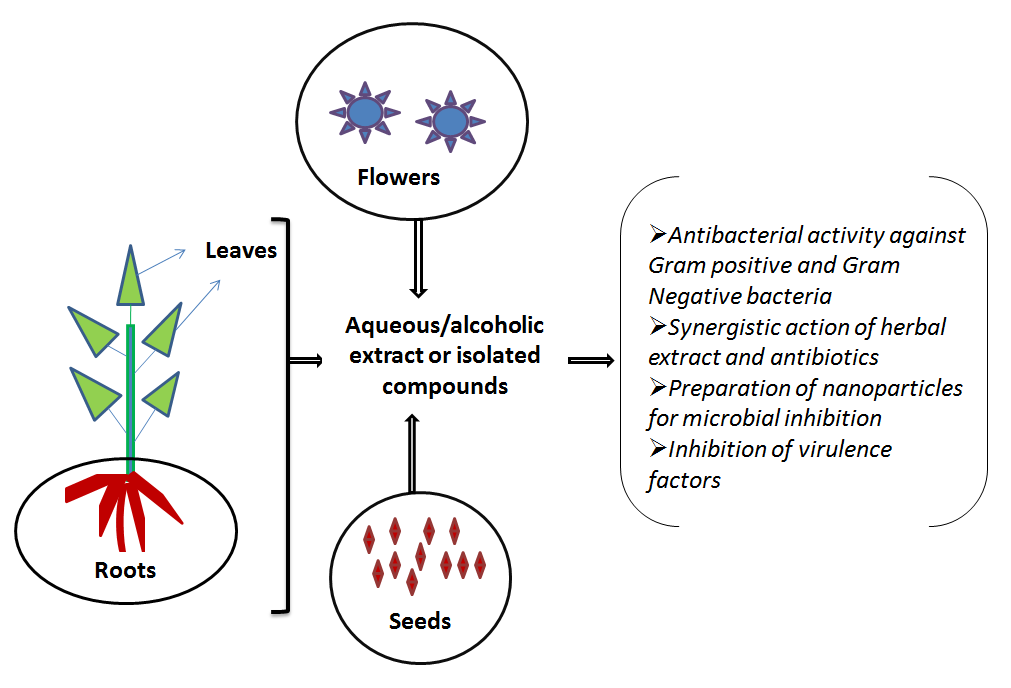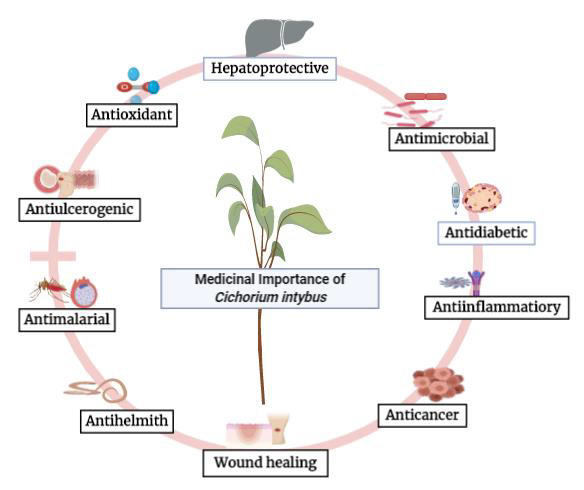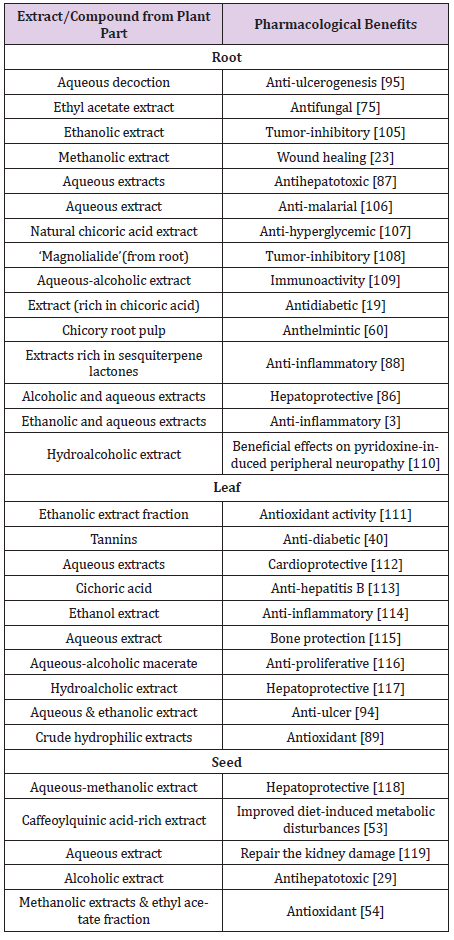Abstract
The astonishing medicinal herb Cichorium intybus is well-known for its huge therapeutic potential. It is an important element of ethnic medication systems practiced in different regions of globe and also consumed as salad or vegetable. A broad spectrum of phytochemicals (chicoric acid, cinnamic acid, caftaric acid, coumarin, anthocynine, triterpenoids, chlorogenic acids, sesquiterpene lactones, caffeic acid, phenolics, flavonoids, inulin, tannin and other chemical entities) in various plant parts have been explored, identified and validated for some medicinal uses. The antibacterial traits of herbal extracts have been depicted against bacteria to diminish the rampant use of synthetic antibiotics. The hepatoprotective, anti-diabetic antioxidant, anti-inflammation, antimalarial, antiproliferative, Immunoactivity and other pharmacological benefits of extract or bioactive compounds were compiled. In this study, a plenty of features including ethnic uses, phytochemical constituents, antibacterial activity, and pharmacological application of Cichorium intybus are described concisely, that may offer an authentic source for further development and exploration of Cichorium intybus for its promising medicinal application.
Keywords: Cichorium Intybus; Antibacterial; Pharmacological Benefits; Phytochemicals
Introduction
Nature provides remedial benefits for mankind through medicinal plants. The human being at somewhat suffering from various ailments and relies on different therapies which are being practiced throughout the world. Besides the modern therapies including allopathy, the ethnic people have the firm believe in herbal plants. Providing treatment through herbal plants may ascribe as ‘herbal therapy’, and it is a conventional mode of treatment employs in various ethnic practices (Ayurveda, Unani and Siddha) [1]. In India, several plants are being employed for curing various ailments. Even the ancient scriptures such as ‘Atharvaveda’ and ‘Ayurveda’ illustrated the remedial application of medicinal herbs [2].
Cichorium intybus (‘chicory’ in English and ‘kasani’ in Sanskrit) belong to ‘Asteraceae’ family, already ascribed for its noteworthy therapeutic values in ‘Ayurvedic medication system’ [3]. Different portions of this medicinal herb have shown excellent medicinal properties. Besides using as a traditional/ethnic medicine, the consumption of this as edible food or salad is also common. As a part folk medicine, the root, leaves, seeds, flower and even the entire plant are utilized to treat different ailments in different nations (Armenia, India, Pakistan, Turkey, South Africa, Georgia, Italy, Iran, Jordan, Morocco, Serbia) [4,5]. It has exhibited marvelous effect as hepatoprotective agent [6] and also gave the natural supplement to cure diabetes [7]. Other beneficial roles showed by chicory are antioxidant, anti-inflammatory, antimalarial, antiproliferative and antiulcerogenic [4]. Besides showing curative properties against number of diseases, this plant was also explored to possess admirable antibacterial activities too [8].
Currently, the extensive antibiotics use engendered the
jeopardy of development of drug resistance pattern in bacteria.
Therefore, the exploration of plants with therapeutic benefits
has been increased as different constituents of plants are affluent
with phytochemicals which inhibit bacterial progression [9]. Wide
arrays of bioactive constituents (phenolic compounds, flavonoids,
quinones terpenes, saponins and alkaloids) kill bacteria through
adapting some cidal actions such.
a) Disruption of the cytoplasmic membrane.
b) Induction of ROS (reactive oxygen species) production.
c) Inhibitory effect against biofilm formation.
d) Hampering cell wall formation.
e) Inhibition of microbial DNA replication.
f) Reduction in energy synthesis and
g) Inactivation of cell envelope transport proteins and microbial
adhesions.
h) Enzyme inactivation, and
i) Efflux pump inhibition [10-12].
All parts of chicory have shown antibacterial activities and thus expand its use to cure general infectious ailments caused by pathogenic bacteria. We herein attempted to review antibacterial activities and other medicinal properties of Cichorium intybus evaluated on studies (both ‘in vitro’ and ‘in vivo’) performed in past decades. This concise report deciphering bioactivities of the extract/bioactive compound will provide the base for the further progression and exploration of Cichorium intybus for medicinal uses.
Cichorium Intybus as Ethnic Herb
Ethnic communities have the wisdom to treat particular disease by using particular medicinal plants, so build a strong bond between human and traditional plants. The traditional knowledge regarding the exploration of herbs bearing medicinal values is transmitted from generation to generation and thus presents ancient wisdom of herbal plants to serve the local people to survive against various ailments. Chicory is also a widely accepted ‘medicinal herb’ and many communities know its medicinal uses. It is majorly grown in Europe, North America, Asia, some parts of Africa and Egypt, Iran and other regions of the globe [13-15]. In Asia and Europe, various preparation of chicory is helpful to cure wide level of diseases including the healing of wound and diabetes, and in Chile, it is consumed as ‘winter vegetable’ [16]. The leaves are consumed as ‘salad’ and ‘vegetable’ in Mediterranean food [17].
In traditional medication system (Ayurveda, Siddha and Unani), the different preparations of this pant (chicory) are given to treat ailments of the hepatic and nephritic system [18]. In India and Pakistan, this herb is potentially used in diabetes in traditional medication system and thus illustrated as well-known herbal plant to show anti-diabetic activity [19]. In countries namely Italy and Bulgaria, the decoction of chicory is popularly well-known for its hypoglycemic trait [19,20]. In South Africa, different plant portions including leaves, roots and stems are usually given to cure jaundice, while the ‘chicory syrup’ is useful for newborns [21]. In Turkey, the leaves are bringing in use to make the ointment containing wound healing trait and root decoction is given for other ailments including cancer and kidney stones [22,23]. The root portion of chicory in folklore medicine is prominently used in curing liver associated ailments and the inflammation of urinary tract [24,25]. Both the imperative parts of plants (leaves and roots) are useful for blood purification and also considered to have anti-arteriosclerosis, antispasmodic, anti-arthritis, laxative and hypotensive activities [26]. In Serbia, the root-decoction is mainly reported to use in liver complaints, diabetes [27], and flower infusion is effective in Diarrhea [28]. In Indian ethno-medication system, numerous plant parts of chicory are utilized in treating several diseases.
The seed has been determined to treat liver disorders [29], while root-decoction is given in some other complications (liver enlargement jaundice, gout, and rheumatism) [30]. The root decoction of chicory under herbal based remedies is also listed against diabetes in Pakistan [31]. In Morocco, the ‘whole chicory plant’ is traditionally important in kidney disorder and diabetes [32], while in Iranian ethnomedicine system the entire plant is employed as botanical drugs for various traditional uses (eupeptic, laxative, stomachic, depurative, choleretic, hypotension, and antipyretic) [33]. Cichorium intybus has the prevalent distribution [23] and it is also bringing in use as ‘forage’ or ‘grazing’ chicory and provides high-quality feed for live stocks with exhibiting antihelminthic trait [34]. In several countries, various plant parts of the Cichorium intybus are used in ethnoveterinary medication for healing purpose and prophylactic uses in both livestock and humans [35,36]. The ethnic wisdom of chicory widens the advanced research platform to further validate the remedial importance of this plant to derive the active herbal-based therapeutics agents.
Phytochemical Constituents
Secondary metabolites or other phytochemicals draw the
special attention of worldwide researchers. The variety of chemicals
may differ in type of plant parts, and hence huge localization of
potential phytochemicals in a specific part of plant depicts its strong
medicinal uses. The phytochemicals synthesis may vary depending
on numerous aspects such as
a) Different varieties or species of plant.
b) Environmental conditions.
c) Agricultural practices and
d) Post-harvest handling.
Moreover, the difference in phytochemicals can be ascribed because of the geographic differences (soil types, humidity, precipitation level, and intensity of light) [37,38]. The plant of Cichorium intybus is laden with numerous groups of chemical entities which introduce multiple medicinal traits. A range of phytochemicals including ‘alkaloids’, ‘flavonoids’, ‘phenolic compounds’, ‘sesquiterpene lactones’, ‘chicoric acid’, ‘caffeic acid’, ‘caftaric acid’, ‘cinnamic acid’, ‘coumarin’, ‘anthocynine’, ‘chlorogenic acids’, ‘inulin’, ‘volatiles compounds’, ‘polysaccharides’, ‘tannins’ etc are proficiently prevailed in chicory plant [4,39-41]. Figure 1 depicts the representative phytochemicals in four important plant parts (leaves, root, seed and flower). The leaves is prevailed with the bioactive compounds including hydroxycinnamic acids (‘gallic’, ‘protocatechuic’, ‘caftaric’, ‘chlorogenic’, ‘caffeic’and ‘cichoric acids’); the flavonoids (‘luteolin 7-O-glucuronide’, ‘apigenin’, ‘apigenin glucuronide’, ‘apigenin 7-O-arabinoside’, ‘quercetin 3-O-glucuronide’, ‘quercetin 3-O-galactoside’, ‘quercetin 3-O-rhamnoside’, ‘quercetin malonyl glucoside’, ‘kaempferol 3-O-glucoside’, ‘kaempferol 3-O-glucuronide’, ‘methyl quercetin glucuronide’, ‘kaempferol malonyl glucoside’, ‘methyl quercetin glucoside’, ‘isorhamnetin 3-O-glucuronide’ and ‘isorhamnetin 7-O-glucuronide’); the anthocyanins (‘cyanidin 3-O-glucoside’, ‘cyanidin 3-O-rutinooside,’ ‘pelargonidin 3-O-glucoside’, ‘peonidin 3-O-glucoside’, ‘malvidin 3-O-glucoside’, ‘cyanidin 3-malonylglucoside’, ‘delphinidin 3-O- (6″ malonyl)-glucoside’, ‘cyanidin 3-O-(6″ malonyl)-glucoside’), and Tannins [40-46]. The important phytochemicals including Hydroxycinnamate (‘caftaric acid’, ‘chlorogenic acid’, ‘cichoric acid’, ‘3,5-dicaffeoylquinic acid’, ‘4,5-dicaffeoylquinic acid’, and ‘caffeic acid’ derivatives), Sesquiterpene lactone (‘11β,13- dihydrolactucin’; ‘lactucin’; ‘8-deoxylactucin glucoside’; ‘jacquinelin glucoside’; ‘8-deoxylactucin’; ‘jacquinelin’; ‘lactucopicrin/11β,13- dihydrolactucopicrin’), polysaccharide, fructose, tannin, volatile oils, inulin, sucrose, cellulose, benzoic acid, verapamil and verbenone in root [16,47-51]. Moreover, the chicory seeds harbor several phytocompounds (‘sesquiterpene glycoside’, ‘caffeoylquinic acids’, ‘anthraquinone’, ‘syringic acid’, ‘beta-sitosterol’, ‘lupeol’, ‘betulinic acid’, ‘sigmasterol’, ‘betunaldehyde’, ‘alkaloids’, ‘flavonoids’, ‘tannins’, ‘saponins’ and ‘vanillic acid’) [4,8,52-54]. Furthermore, the flower also ascertained to contain bioactive compounds namely ‘flavonoids’, ‘essential oils’, ‘anthocyanins’, ‘methoxycoumarin’, ‘cichorine’, ‘lactucin’, ‘intybin’ and ‘saccharides’ [4,54-56].
Figure 1: Diagram representing phytochemicals in different parts (leaves, shoot, seeds and flowers) of Cichorium Intybus.
Need of Cichorium intybus for ‘Phytotherapy’
A huge section of world population (about 80% human populations) lives in developing nations and relies basically on herbal plants for curing health related issues [57]. Then, it needs to develop herbal formulations to treat people suffering from several ailments, and further promotion of herbal-based medicines which stated to be potential usage in the conventional medication system and validated on scientific ground. The herbal preparations used for medication are comprised of specific plant part either in ‘crude’ and/or ‘processed’ state and combination of plants containing active ingredients. Drugs from herbal/natural sources are more striking than the drug prepared from synthetic means due to many reasons such as affordability, diversity, accessibility with lesser effects [58]. A huge diversity of bioactive components exists in variety of phytochemicals also draws the therapeutic significance of chicory [59,60]. The content of phytochemicals may differ in whole plant/precise section of the herb and in the extracted material. Therefore, it becomes necessary to assess the pharmacological importance of herbal plant extract and their constituents containing phytochemicals with traits of multiple medicinal properties. Currently, a curiosity among the researchers is to widen the area of ‘chicory derived herbal drugs’ through understanding the mechanism of action behind showing any specific medicinal trait rather than simply relies on faith and folk or tradition. Moreover, proper studies are also to be done to illustrate the means of microbicidal efficacy of chicory in broadways that is still lack in previous studies. From the research studies, it is envisaged that government-funded laboratories; drug companies and other associated and relevant scientific communities will have a look at this medicinal herb with a view to further exploration and subsequent development of herbal products to better the lives of disease victims and to reverse the drug resistance effects of antibiotic-resistant bacteria.
Cichorium Intybus: as a Natural ‘Antibacterial Agent’
Evaluating the antibacterial efficacy of plants is a fine idea over
the antibiotic uses. It may decline the uncontrollable antibiotics use
and associated risk factors such as the expansion of drug resistant
or multidrug resistant bacteria [61]. Extracts encompasses plenty
of bioactive compounds including alkaloids, phenolic compounds,
coumarins, terpenes, flavonoid, saponins and organosulfur
compounds, and inhibit microbial growth through different
mechanisms [62,63]. Still the usage of herbal based materials is
common in numerous ethnic groups for curing bacterial infections
[64] and several herbal based compounds showed anti-microbial
potential against drug-resistant bacteria and disrupted the
virulence factors of pathogenic microorganisms through exhibiting
‘antibiofilm activity’ [65]. Chicory herbal extracts (aqueous and
alcoholic extracts) have shown auspicious antibacterial traits
against both kinds of bacteria.
a) Gram positive bacterial strains and
b) Gram-negative bacterial strains [66].
The leaf extracts were also evaluated against Helicobacter
pylori [67] and Salmonella typhi (a multidrug resistant strain of
Salmonellatyphi) [2]. The virulence-associated activities of some
oral microbial pathogens (Actinomyces naeslundii, Streptococcus
mutans, and Prevotella intermedia) were aborted in the response
to ‘low molecular mass extract’ of Cichorium intybus var. silvestre
(‘red chicory’) [68]. The tested herbal extract of Cichorium intybus
presented more and promising antibacterial action but lesser
antifungal activity. The silver nanoparticles prepared through
green mode by using the chicory extract exhibited antibacterial
property against Escherichia coli, Pseudomonas aeruginosa
and Staphylococcus aureus [69]. The phytochemicals with the
antibiotics act synergistically to neutralize drug resistant bacteria
through exhibiting various antimicrobial mechanisms such as
quelling the activity of ‘antibiotic degrading enzyme’, preventing
target modification and blocking ‘efflux pumps’ [70]. Synergistic
action of herbal extracts of chicory and antibiotics (amoxicillin
and chloramphenicol) were examined against certain bacteria
(Escherichia coli, Bacillus subtilis, Klebsiella pneumonia, Proteus
mirabilis, Pseudomonas aeruginosa, Enterobacter cloacae, and
Staphylococcus aureus). The resultant combinations of extracts
(ethyl acetate extract and acetone extract) of chicory with the
antibiotics showed ‘additive’ and ‘indifferent’ effects against some
test bacterial strains [71]. An overview of herbal extracts of different
portions of chicory may endow with multiple strategies for testing
antibacterial activity (Figure 2). In previous studies, different parts
rendered the antibacterial properties of Cichorium intybus against
bacteria are given in Table1 [71-83].
Medicinal Values of Cichorium Intybus
Wide arrays of research explored the therapeutic potential of various plant parts of chicory including root, leaves, seeds, flower and even the whole plants, and also elucidated the medicinal values of isolated compounds. The Cichorium intybus is a stupendous hub of various bioactive compounds which depict medicinal values. Several medicinal importance of chicory is illustrated in Figure 3. Moreover, several pharmacological studies are based on testing the botanical extract (aqueous/alcoholic extracts) from root, leaves, and other parts including seeds of the plant.
As a herbal/natural supplement, it has shown the wide spectrum therapeutic traits such as hepatoprotective [84-87], antidiabetic [30], antibacterial [68] anti-inflammatory [88], and antioxidant [89]. As a hepatoprotective agent, it also decreases the threat of liver cirrhosis [6]. Other pharmacological application of chicory includes antihypoglycemic, antihyperlipidemic [90,91], anticancer [92], anti-allergic [93], anti-ulcerogenic [94], gastroprotective [95], anti-protozoal [96], and wound healing activities [23]. It has evaluated to be an anti-hyperuricemia agent [97], and also depicted anti-rheumatic effects [98]. Pharmaceutical significance of the herbal plant relies on the existence of lead molecule/phytochemical in different constituents of plants. Determining the bioactivities of potential phytochemical with in vivo animal studies is necessary for further exploring multitude medicinal properties of plants [40].
Recently, the development of efficient pancreatic β cells from stem cells under proper conditions or replacing the ‘degenerative pancreatic β cells’ by ‘insulin-producing cells (IPCs)’ depict the very auspicious option to cure diabetes [99,100]. Chicory extract was effectual to provoke the differentiation of ‘P19 EC cells’ into the clusters analogous to pancreatic islets also with exerting the functional, molecular, and cellular characteristics of ‘mature β cells’ [101]. An important material substance in chicory namely ‘inulin’, is attributed to be beneficial for the patients with ‘type 2 diabetes’ [102]. A study showed potential role of root extract in osteoarthritis management [103]. Hydroalcoholic extracts were also helpful to defend against acute pancreatitis [104]. Important pharmacological benefits of chicory extract or isolated compound based on in vitro/in vivo studies are depicted in Table 2.
Conclusion
The plant of chicory (Cichorium intybus) is being practiced in ethnic system since ancient times as a natural/herbal medicinal source, and as well as a vegetable crop. Each important portion of this plant (leaves, root, seeds and flower) represent the ‘medicinal phytochemistry’ as a result of the presence of vast arrays of phytochemicals. Herbal extracts/bioactive components from this plant depicted the various clinical applications which had been supported by investigating some biological activities including antibacterial activities and other numerous pharmacological advantages.
Acknowledgment
We are thankful to the authorities of respective departments (a) Department of Molecular Biology & Genetic Engineering, College of Basic Sciences and Humanities, Govind Ballabh Pant University of Agriculture & Technology, Pantnagar (India), and (b) DBT (Department of Biotechnology)- New Delhi, for the support of carrying out this work.

 Review Article
Review Article




